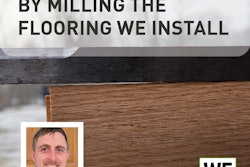The Problem
I was commissioned by a wood flooring contractor to examine the quality of the wood flooring purchased by the homeowner and to inspect the wood flooring already installed in the basement of a magnificent new Georgia home.
The Procedure
The homeowner had chosen an unfinished engineered white oak ½-by-3 3/8 -inch floor in random lengths for his basement. He knew the flooring did not have a warranty but chose to have it installed anyway; it was glued to the basement slab with a moisture-cured adhesive. After the floor was installed and sanded, the homeowner walked over the floor and felt many boards flex. The contractor explained that more than 100 boards separated during the sanding process. He believed the homeowner had purchased a batch of defective flooring.
The Cause
The first thing I noticed was approximately 100 boards with raised edges and at least 100 with overwood at end joints. A number of boards had part of the surface missing. At end joints where the overwood was very noticeable, I slipped my prybar between the first and second layers of wood. The top layer easily pulled up. Next I lifted several boards glued to the subfloor. This was difficult: Each board split and broke into small pieces, so a hammer and wood chisel had to be used. All moisture testing indicated that the concrete subfloor and wood flooring were within an acceptable range.
Five boxes of unused wood were in the garage, and I inspected random pieces. Approximately 50 percent were defective. Boards had cracks along edges between the top and second layer, and several layers could be separated by hand. An inspection clearly showed an absence of adhesive between the top and second layers. Some boards had 4 to 10 inches without adhesive. It appeared that during manufacturing the adhesive applicator machine malfunctioned or ran out of adhesive; I believe the manufacturer found the error and sold the product as "defective" without warranty.
How to Fix the Floor
The homeowner realized the mistake, paid my client to remove the wood, and paid for the labor and costs to prepare the basement concrete for a second installation. He ordered a different unfinished engineered wood floor, but during the sanding process workmen noticed puckers along edges of boards and overwood at end joints. Again I was called; I examined the new wood and found the same defects as before—many boards could easily be pulled apart by hand. The homeowner said he wasn't going to pay for the labor and removal for the second floor, and things got interesting. It was my conclusion that the second conflict resulted from both product failure and negligence on the part of the wood flooring contractor.
In the Future
In a sense, a wood flooring contractor is the last "inspector" of a wood floor. Installers are generally considered responsible for checking the appearance of the boards (the correct grade, species, etc.), making sure the tongue and groove go together, and checking moisture content. Installers are not held responsible for structural errors in the construction of engineered flooring that may not be obvious until after installation. In this case, however, the flooring was so bad that a professional should have easily noticed this problem before installation and refused to install the floor. Even though the wood flooring contractor had no say in selecting the flooring, since he knew it came without a warranty, it would have been wise to check it more carefully (especially the second order). If he had, he would have noticed the problems before installation and avoided a messy dispute. If a customer insists on buying a product of questionable quality, sometimes the best choice is to walk away.






























